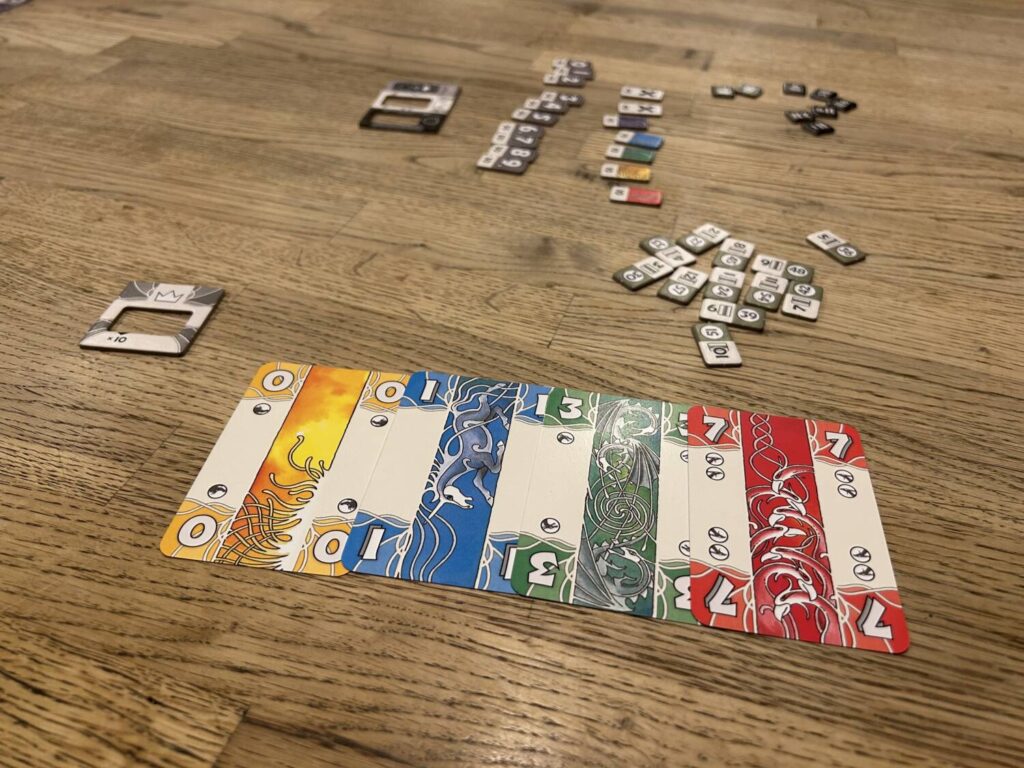Disclosure: Meeple Mountain received a free copy of this product in exchange for an honest, unbiased review. This review is not intended to be an endorsement.
Don’t let the current vogue for trick-takers fool you. For decades, new trick-taking games weren’t being released at such a clip that you could use them as ammunition in a gatling gun. Even when hobby gaming started to take off, once the industry as a whole exceeded “it’s feasible to play every game released in a year,” trick-taking was a fairly niche concern.
It was during that time that some of the foundational legends of modern trick-taking were released. Foremost among them was 1995’s Mü & More, from designers Doris Matthäus and Frank Nestel. Out of print for quite some time now, Mü & More has been revived by publisher Heidelbär Games, who have made some quality of life improvements but otherwise left the game untouched.
Move to the Müsic
Mü & More is a collection of five card games, each played with the same unusual deck: five suits, cards valued from 0-9, with two 1’s and two 7’s in each suit. The primary draw is Mü, a trick-taking game in the tradition of the French tarot and bridge. Most modern trick-takers find their “but”s, the little and large changes to formula that give them their individual character, in the card play itself, but that’s not the case with Mü & More. This is a must-follow trick-taking game. That’s it. That’s the card play. Win a trick, take the cards, lead the next trick.
If you’ve heard of Mü, but aren’t particularly familiar with it, that might be surprising. It has a reputation for being a gnarly, dense thicket of rules, at least in comparison to its kin. That’s because a good deal of Mü’s meat is found in the bidding that precedes each round.
Before I explain the mechanics of the bidding, let me explain the point of the exercise. For each hand, players are divided into two teams, led by the Sword and the Shield. The Sword and their partner have to win a predetermined number of points during the hand. The Shield and their two deputies—this is a game best at five—have only to stop Team Sword from achieving that goal. At the end of the hand, each player scores their own points individually, and all members of the winning team receive a bonus.
Everything I just described hinges on the bid.
Starting with the player to the left of the dealer, you can reveal any number of cards from your hand. Cards revealed in this manner are still considered a part of your hand, but they stay on the table for everyone to see until they are played into a trick. The first player to bid becomes the Sword. If a subsequent player reveals a higher number of cards, they take the Sword placard, and the previous Sword becomes the Shield. If anyone matches the Sword’s bid, or exceeds all other bids at the table without surpassing the Sword, that player becomes the Shield. This process goes round and round until everyone is content.
There are a few pressures on your bid, and it’s hard to fully grasp how to reconcile all of them in your first few plays. Hell, it’s hard to reconcile them after a dozen plays. Here I present an enumerated list, in no particular order, of all the factors to take into account when placing your bid:
1. The number of cards revealed by the Sword determines the number of points Team Sword has to win during that hand. The more cards the Sword reveals, the more points they have to score.
2. The number of cards revealed by the Sword and the Shield factor into the bonuses that their teams receive. The more cards revealed, the higher the bonus.
3. Before the hand starts, the Shield picks either a rank or a suit to render trump for that hand, then the Sword picks a rank or a suit to render trump for that hand. The rank or suit chosen by the Sword outranks the rank or suit chosen by the Shield. In the event that one chose a rank and the other chose a suit, the cards that sit at the intersection of those choices are the most powerful cards of all. To put this another way: Namita, the Shield, decides to make Blue the weaker of the two trumps. Bryan, the Sword, makes 2 the stronger trump. The Blue 2 is now the strongest card in the game.
3a. BUT, you can only choose a rank or a suit that you have revealed as part of the bidding process. I can’t reveal a bunch of chaff and then make what I have hidden in my hand the most powerful part of my strategy, and neither can you.
3b. The choices for trump also affect the end-of-round bonus for the winning team. The suits and ranks have different bonus values, and No Trump is also a choice.
4. The Sword chooses their partner for the round after bidding has completed and after both trump suits have been selected. There is a degree to which bidding can be an audition, signaling to the clear power players for that hand that you feel yourself to be in a pretty good position.
4a. Alternatively, you may intuit that you’re in a good position to ruin some of the best laid plans of mice and men, and choose not to reveal cards you think are likely to become nominated for trump.
It’s an intoxicating mix of pressures. You are simultaneously encouraged to up your bid and punished for getting too carried away. Mü is not considered an auction game, but speaking as someone who adores an auction game, Mü has one of the more impermeable and inscrutable auctions I’ve ever had the absolute pleasure of experiencing. Ra, High Society, Modern Art, and Mü, there’s your Mount Rushmore.
Heidelbär has done some great work to streamline the complexities of this. There are now tokens for the Sword and Shield to place in their placards that remind everyone at the table how many points Team Sword needs to win, and what the various bonuses are. The trump suits are laid out conveniently for all to see. There’s a QR code that links to an online scoring sheet, which definitely helps. I’m less fond of Heidelbär’s decision to leave the rules for the & More part of Mü & More online instead of including them, but every other choice is top-notch.

More or Less
The question is, will Mü & More hold up for a contemporary audience? I don’t know! Board games and board gaming have changed a lot since the 1990s. We’re living under a much bigger tent, for one thing. The expectations of circulation and sales are much higher than they used to be. Things have to connect quickly, you have to Get It on the first play, or the game gets lost in the deluge of New.
Because of the expectation of a mass market product, a lot of the rough ludological corners have been sanded down. Designs aren’t generally allowed to be ungainly in the same ways they used to be, which is often a good thing, but games like The Princes of Florence and Tigris & Euphrates wouldn’t have survived the contemporary development process. Are they a bear to learn? Yes. Are they particular and singular experiences in which every rule adds something? Absolutely. Mü & More too belongs in that lineage, games that require and reward patience. It comes from an age when you would play something a few times before deciding what you thought, because we didn’t have Netflix yet.
We do have Netflix now, and our attention spans ain’t what they used to be. For the seasoned veterans of trick-taking, Mü & More is a blast. I often find myself struggling with what the right choice is, and I love that feeling. That does mean this isn’t a good place to start with trick-taking, and I worry that every game now needs to be a place to start. Give it time and space, and Mü can be so much more than that.











Add Comment